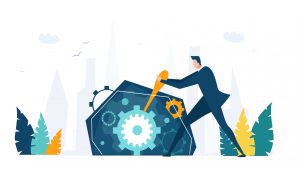- Devin Djerf
- Reading Time: 5 minutes

With SAP RISE in its third year on the market, UpperEdge has observed several key insights around SAP’s tactics to drive the adoption of RISE. At this point, the adoption of RISE is not a question of if; it is a question of when customers will move to RISE. At SAP’s annual Sapphire conference last week, SAP stated that RISE has now been adopted by over 6,000 customers, and it is clear that RISE and AI adoption are of critical importance to SAP.
SAP is marketing RISE as a comprehensive ERP transformational solution inclusive of software, infrastructure, maintenance and technical services. However, as prospective customers explore this offering, they are realizing that not all relevant technical services come standard with RISE. The infrastructure is based on generic t-shirt sizing, and cloud line of business solutions (i.e., Ariba) are out of scope and need to be purchased separately.
Joule, SAP’s generative AI copilot, was also a consistent theme at Sapphire, with SAP promising that the tool will save time and increase customer productivity. SAP’s Joule will be fully integrated with Microsoft’s Copilot. Christian Klein, SAP’s CEO, stated that SAP is “entering a new phase of AI with endless possibilities for all of us.”
Here, we will outline the current state of the market as it relates to RISE, the levers that SAP is pulling to drive adoption of both RISE and AI, and what customers need to consider when evaluating a move to RISE.
What We’re Seeing
Based on SAP’s aspirations and their expectations conveyed to Wall Street, the changes made to the compensation structure for their salesforce, as well as the strategic alliances formed within their partner ecosystem, it is evident that SAP has gone all-in to aggressively push customers to RISE. As a result, we have seen SAP be forceful in its singular focus to drive customers to select RISE over the perpetual model.
In addition to dedicating new roles to drive RISE adoption (i.e., Head of RISE), changing the go-to-market strategy for ERP, and shifting the incentive structure for its salesforce, there have been notable leadership changes as well. SAP has appointed Dominik Asam as their new CFO, replacing Luka Mucic in the position. Additionally, the new head of North America, Lloyd Adams, has stepped in following the departure of DJ Paoni.
In an effort to maintain positive partnerships and ensure successful delivery of RISE, SAP will now assign an Enterprise Architect to new and existing SAP customers.
SAP is now offering three editions of RISE: 1) Base Edition, 2) Premium Edition, and 3) Premium Plus edition. Although not clearly stated at Sapphire, only SAP’s Premium Plus edition comes standard with additional capabilities for Generative AI, sustainability, and supplier networks. It will be important for customers to be aware of and conduct due diligence on how customers can reap the benefits of AI without having to execute a Premium Plus deal.
We’ll be keeping tabs on how this new leadership team will attempt to influence RISE adoption and if SAP continues to surpass its growth ambitions for RISE. In the meantime, we have outlined the main tactics to expect from SAP for those clients planning to pursue a RISE evaluation.
RISE vs. Perpetual Tactics
1. Non-Competitiveness of Perpetual Model Discounting
In some cases, SAP has attempted to provide clients with only a RISE proposal and not a perpetual proposal in order to limit their options and drive customers to adopt a full cloud landscape. When customers are given a perpetual proposal, SAP has implemented terms that drive customers away from the perpetual deal and towards RISE, such as less favorable discounts and reduced commercial term flexibility. Not only are the perpetual discounts generally less than the RISE discounts, but they are also far less than the historical discounts clients used to receive with ECC and Perpetual S/4HANA. As expected, Sapphire focused largely on new innovations for Cloud with little emphasis for SAP’s On-Premise customers.
2. Audits
Another tactic SAP has utilized comes in the form of audits. SAP has threatened to launch audits and pursue penalties for non-compliance audit findings unless customers enter into a RISE Agreement. SAP has used other unique circumstances such as Divestitures and Acquisitions to influence RISE adoption as well.
3. Pushing RISE and GROW on Net-New Customers
New SAP clients with a greenfield environment should expect an uphill battle obtaining a reasonably competitive perpetual proposal. While there are certainly situations where RISE is more favorable, we recommend new clients pursue both RISE and perpetual proposals in order to conduct a proper evaluation fit. It was announced at Sapphire that GROW, SAP’s cloud ERP offering for midsize and subsidiaries of larger organizations, will include SAP Sales Cloud and SAP Concur Expense as part of the Premium offering.
4. Leveraging the Hyperscalers and SIs
The hyperscalers and SIs are also playing a key role in pushing customers to RISE. For example, SAP announced its partnership with AWS, making it clear that SAP’s strategy with AI is going to be centered on its partnership with AWS. Additionally, Accenture’s SOAR complements SAP’s RISE offering and is another avenue clients can utilize for adoption. It will be important for customers to determine how value can be achieved across the various hyperscalers and SIs, given SAP’s partnership announcement with AWS.
5. Top-Down Commitment
Additionally, SAP is leveraging executive-level interactions to sell the benefits of RISE, even when the project team believes a perpetual model would be more appropriate. SAP’s talking points include making ‘approval exceptions’ for certain commercial terms and persuading clients that they don’t want to regret being off the growing list of RISE customers. It was unclear how SAP’s new enhancements related to Generative AI will impact customers financially and commercially. SAP is also focusing largely on the “Clean Core” methodology, which will push customers away from customizations and toward standardization of business processes.
The Final Decision in RISE and AI Adoption
As SAP’s aggression towards RISE only continues to grow, it will be important for SAP customers to be aware of SAP’s objectives and sales tactics prior to any upcoming discussions or transactions with SAP. Understanding the tactics that SAP will utilize, including leveraging the influence of their partners, minimizing the flexibility within their perpetual proposals, and driving top-down commitments, will help you come to your discussions informed and prepared. It will also be important to determine how SAP is using customer data to develop their large language models for AI capabilities. SAP conducted a poll at Sapphire where customers were asked about their top concerns with AI, and the top answer was Data Privacy and Regulation.
To help mitigate these tactics, we recommend clients insist upon receiving a Perpetual proposal from SAP in order to properly evaluate it with the RISE model. We also recommend clients push to receive full transparency across both proposals, assess the risks and operational impacts of both models, and consider the long-term TCO implications.
Customers should assess and evaluate whether RISE is a better alternative to the perpetual model and if they meet your goals, especially given that Generative AI will only be offered for SAP’s cloud customers. SAP is going to push you towards RISE, but you need to be prepared for the complexities that come with choosing the RISE model, including pricing, commercial, and capabilities perspectives, to be able to make this decision.
Given the ever-changing environment and complexities of this evaluation, consider working with our dedicated team of SAP advisors to leverage our experience and strategic guidance. Explore our SAP Advisory Services to see how we can help in your RISE and AI adoption strategy.
This blog was co-authored by Michael Wesseler.
